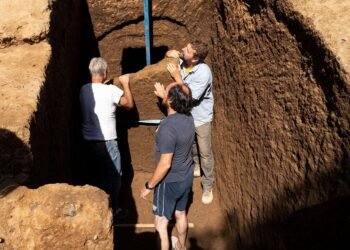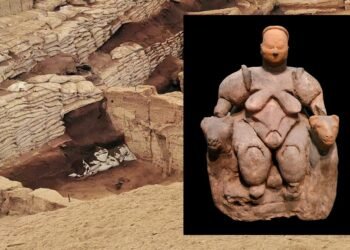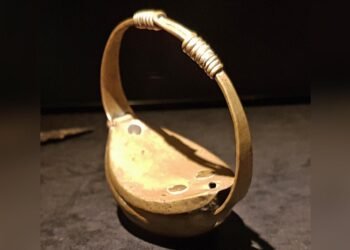In a series of ongoing excavations at İnkaya Cave, located in the northwestern region of Turkey, in Çanakkale, archaeologists have uncovered compelling evidence of human life dating back 86,000 years. The cave has also yielded a plethora of flint tools, indicating the multifaceted purposes they served for ancient people.
The İnkaya Cave, situated in Bahadırlı village within the Çan district, was initially identified during the Muğla and Çanakkale Provinces Survey in 2016, led by İsmail Özer, a lecturer at Ankara University in the Department of Paleoanthropology. The excavation efforts have continued for six years, making it a focal point of research in the region.
This year’s excavations, conducted by a team of 20 experts, revealed that humans from the Middle Paleolithic Period resided in the area for extended durations due to the abundant availability of flint raw materials and essential water resources. This finding points to the significance of the site in understanding the migratory patterns of ancient populations between Anatolia and the Balkans during the Paleolithic period.
Professor Ismail Özer, who oversees the excavation, remarked, “Evidence of the Paleolithic era in Çanakkale was previously limited. Through our research, it became evident that Çanakkale is actually one of the very rich provinces in Türkiye in terms of the Paleolithic period.” He emphasized the unique nature of the findings in Çanakkale, highlighting the scarcity of cave excavations in Turkish provinces, with most archaeological efforts concentrated in open areas, primarily in the southern regions.
The İnkaya Cave site has yielded insights into the Middle Paleolithic Period, spanning from approximately 250,000 to 50,000 years ago, suggesting a robust presence of ancient populations during this time frame. The precise dating of the finds on the eastern slopes of the cave establishes an astonishing timeline, tracing back to 86,000 years ago.
Despite the wealth of information derived from the excavations, the remains obtained thus far are primarily limited to flint artifacts. Organic remnants, such as human skeletal remains, animal bones, or plant residues indicative of ancient diets, have not yet been uncovered.
Nonetheless, the importance of the İnkaya Cave lies in its unique geological composition, mainly consisting of flint rock formations. This geological characteristic made the cave an attractive choice for early humans, as they could craft tools for daily use while conveniently sourcing raw materials from within the cave itself.
Among the fascinating artifacts discovered in the cave are tools made of flint, which display various forms and functionalities. A particular find includes a toothed tool, speculated to have functioned similarly to modern-day saws. Tools with handles were also found, likely inserted into tree branches, bones, or horns using resin.
The process involved thinning out the handle portion and working on the edges to make them functional. These tools could have been employed for activities such as digging soil or scraping animal skins. The specific purposes of these tools will be further elucidated through microscopic analysis of the stones in the future.
Özer stated that the excavations at İnkaya Cave persist both within the cave itself and in the surrounding open area settlement.
























